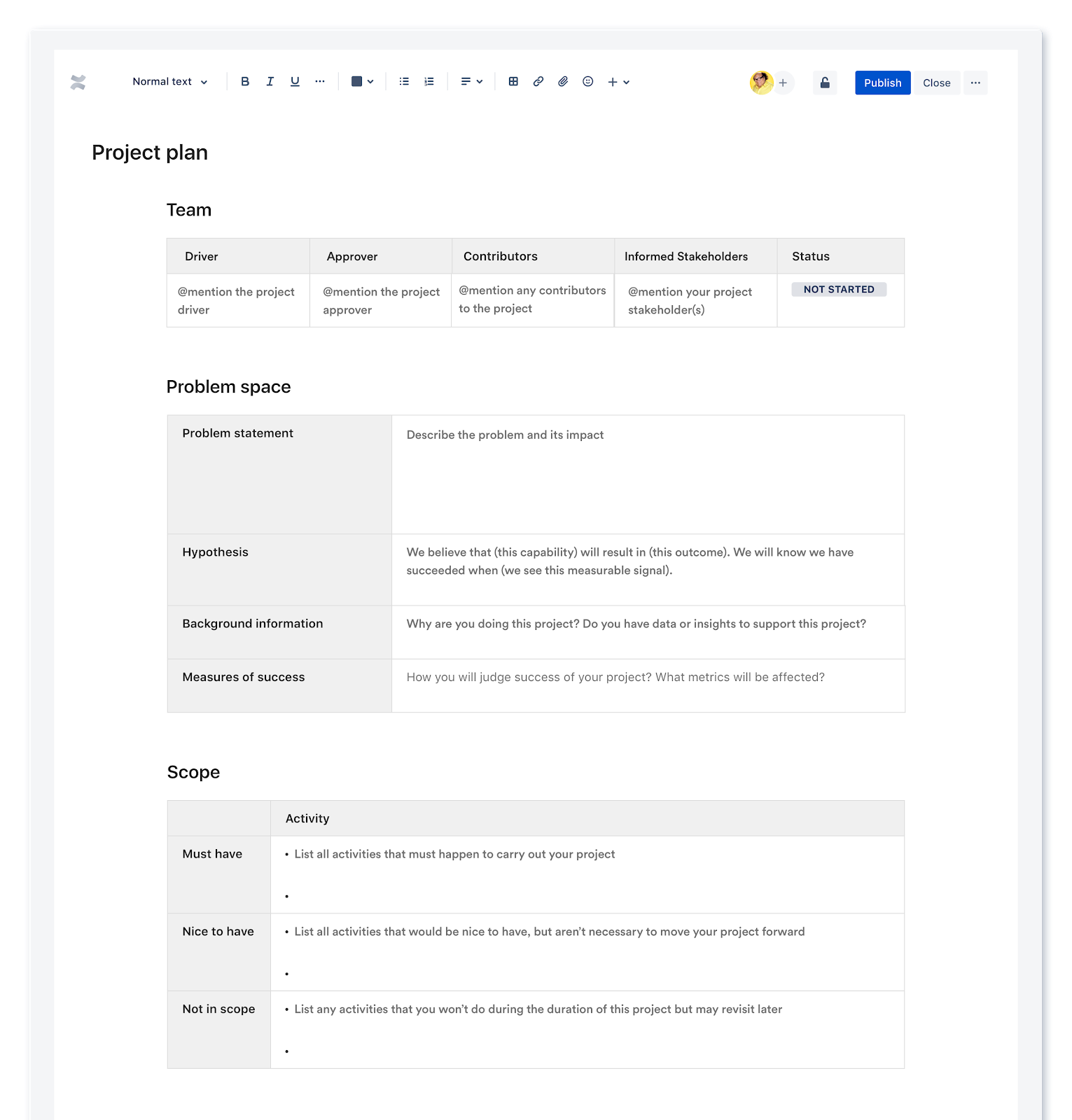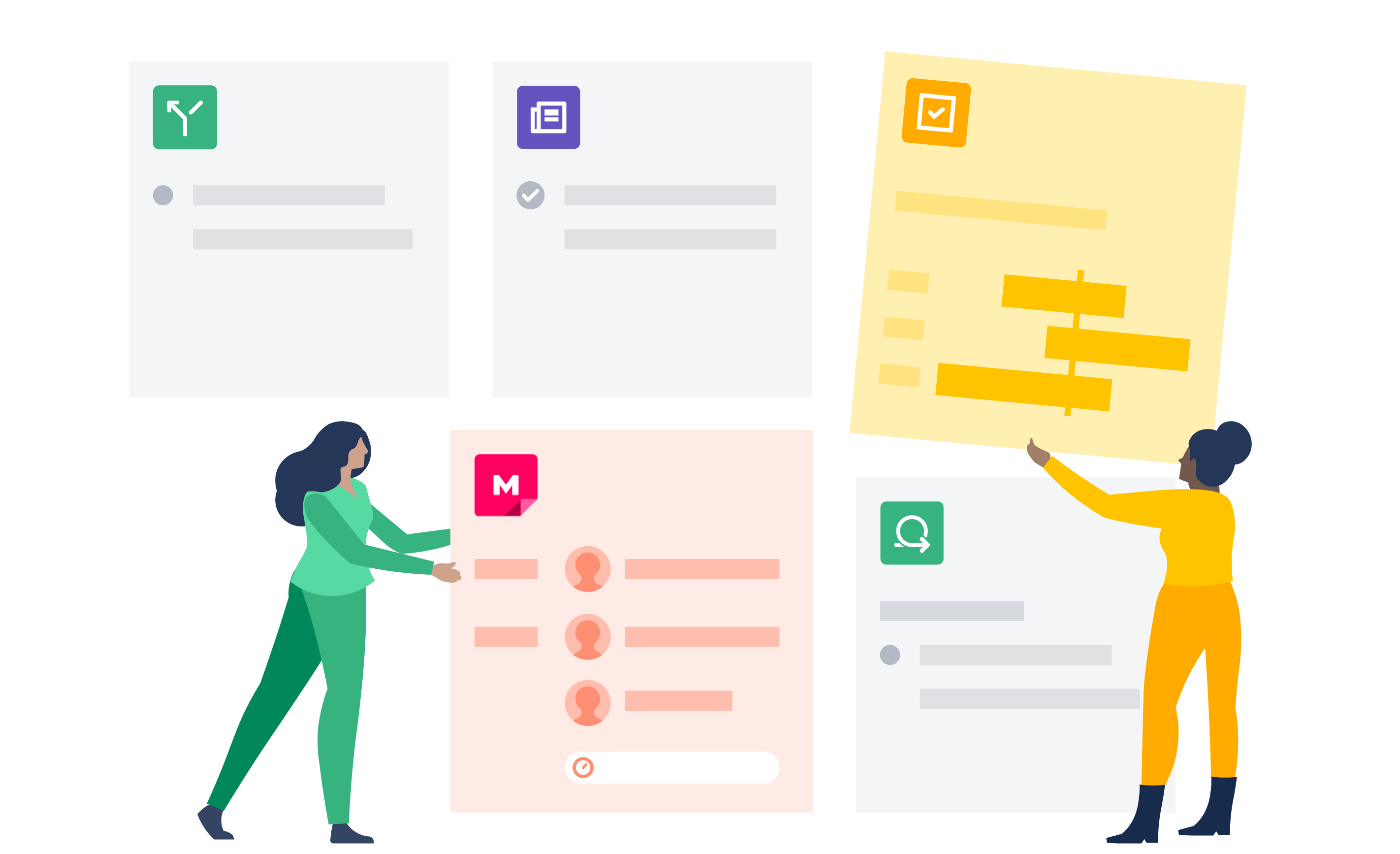プロジェクト計画書とプロジェクトポスターの違いは?
この記事では、プロジェクト管理に欠かせない 2 つのツール、プロジェクト計画書とプロジェクト ポスターの違いについて説明します。どちらもプロジェクトを開始し、計画するための手段ですが、用途は大きく異なります。プロジェクト計画書は、正式かつ静的な文書であり、プロジェクトの目的、目標、重要な詳細を概説する基本的なブループリントとして機能します。
対照的に、プロジェクト ポスターはダイナミックなツールであり、プロジェクトの進行に合わせて変化する視覚的な概要を提供します。以降のセクションでは、それぞれのユニークな特徴について詳しく説明します。プロジェクト計画書はプロジェクトの正式な土台を築くものであり、プロジェクト ポスターは継続的な計画と視覚化のためのダイナミックなガイドとして、プロジェクトのライフサイクルのさまざまなニーズや段階に応えるものである点が強調されています。
プロジェクト計画書とは?
プロジェクト計画書(概要説明書)は、プロジェクトの目的、目標、スコープ・ステートメントの概要を記載した文書です。プロジェクト開始の正式な承認の役割を果たし、プロジェクトの計画と実行の基礎となります。プロジェクト計画書には通常、次のような重要な情報が含まれています。
- プロジェクトのタイトル:簡潔でわかりやすいプロジェクトの名前。
- プロジェクトを実施する目的または正当な理由:プロジェクトの目的と期待されるメリット。
- プロジェクトの目標:プロジェクトで達成を目指す、具体的で測定可能な目標。
- プロジェクトの範囲:具体的な目標、タスク、費用、締め切りなど、プロジェクト要件の説明。
- プロジェクトの成果物:プロジェクトによって生み出される具体的な製品またはサービス。
- プロジェクトの関係者:顧客、スポンサー、チーム メンバーなど、プロジェクトに利害関係を持つ個人やグループのリスト。
- プロジェクトのタイムライン:重要なマイルストーンや締め切りを含む、プロジェクトのスケジュールの大まかな概要。
- プロジェクトの予算:費用、人員、その他のリソースなど、プロジェクトの実施に必要なリソースの見積もり。
全体的に見て、プロジェクト計画書は、プロジェクトの目的、スコープ、期待される成果について、プロジェクトの主要な関係者とスポンサーすべてに共通の理解と合意をもたらします。また、プロジェクト管理プロセス全体を通じて基準点としての役割も果たし、プロジェクトが順調に進んでいて目標に適合していることを確認するのに役立ちます。
プロジェクト ポスターはなぜ重要なのか?
プロジェクト計画書は、構造化された基盤を提供し、いくつかの具体的な利点を提供することで、プロジェクト管理プロセスにおいて極めて重要な役割を果たします。まず、プロジェクトの目的、目標、スコープを概説することで、プロジェクト・チームに明確な方向性を示す羅針盤の役割を果たします。この明確さにより、共通の目標に向けた取り組みの足並みを揃え、優先順位が分かれるリスクを最小限に抑えることができます。また、プロジェクト計画書は、潜在的な課題や不確実性を事前に特定することで、効果的なリスク軽減に貢献し、積極的な計画とリスク管理戦略を可能にします。
さらに、プロジェクト計画書はリソース配分の最適化にも役立ちます。タスク、コスト、締め切りなどのプロジェクト要件を詳しく説明することで、人的リソースと財務的リソースの両方が、プロジェクトのニーズに合わせて適切に配分されるようにします。これにより、効率が向上し、リソースのボトルネックを防ぐことができます。もうひとつの大きな利点は、プロジェクト計画書によって、情報に基づいた意思決定が容易になることです。関係者は、プロジェクトの目的、期待される利益、潜在的なリスクを包括的に理解することで、プロジェクトのライフサイクルを通じて十分な情報に基づいた意思決定を行うことができます。
最後に、プロジェクト計画書は、関係者間の文書化された合意として機能し、作業証明と説明責任の基礎となります。このことは、透明性を高め、プロジェクトの実施中に発生する可能性がある紛争や誤解を解決するのに役立ちます。要約すると、プロジェクト計画書は、明確なガイダンス、リスク軽減戦略、最適なリソース配分、情報に基づいた意思決定の枠組みを提供することで、プロジェクトの成功に貢献します。
プロジェクト ポスターとは?
プロジェクト ポスターは、プロジェクト・マネージャーやチームが、解決しようとしている問題、考えられる解決策、プロジェクトの理想的な最終結果について考えるためのプロジェクト計画ツールです。プロジェクト ポスターは散発的なアクティビティではなく、プロジェクトの概要を説明する文書です。静的なプロジェクト計画書とは異なり、プロジェクト ポスターは、プロジェクト・チームが調査やプロジェクト・アクティビティを進めるにつれて進化し、更新されるように設計されています。
プロジェクト ポスターは、チームが問題についてじっくり考え、考えられる解決策を模索し、プロジェクトのビジョンを磨くためのダイナミックなツールです。このような継続的な更新により、ポスターはプロジェクトのライフサイクルを通じて関連性のある貴重なリソースであり続け、プロジェクトの進化に適応します。
プロジェクト ポスターはなぜ重要なのか?
プロジェクト ポスターは、チームのプロジェクト計画の開始点です。最終的には、プロジェクトのリスクや、どのような解決策を追求すべきかについての結論を導き出し、何を提供するか、そのためには何が必要かといった理想的なプロジェクト・ビジョンを描くのに役立ちます。
プロジェクト ポスターにより、チームは次のような重要な質問に答えられるようになります。
- どんな問題を解決しようとしているのか?
- なぜ自分がこの問題を解決することが重要なのか?
- このプロジェクトの目標と目的は?
- 分かっていることは何か、また足りない情報は何か?
- 考えられる解決策は?
プロジェクト ポスターとプロジェクト計画書の違いは?
プロジェクト ポスターとプロジェクト計画書にはいくつか相違点があります。プロジェクト ポスターはプロジェクト計画書とは異なり、常に更新されるドキュメントです。問題の範囲の調査、仮説への反論、解決策の検証、フィードバックの収集、次に進む前の軌道修正などに応じて、プロジェクト ポスターを更新できます。
プロジェクト ポスターには、次のような情報を整理するためのカテゴリーが 3 つあります。
問題の範囲:これはプロジェクト・ステートメントです。この問題を解決することが顧客およびビジネスにとってなぜ重要なのかを説明します。プロジェクトの目的や考えられる解決策を明確にします。
検証:知識のギャップとリスクを特定します。知っていることは何ですか?また、何を明らかにする必要がありますか?
実行の準備:解決策を可視化し、プロジェクト計画を実行します。
プロジェクト ポスターの例については、こちらをご覧ください。
Confluence でプロジェクト ポスターを作成するためのヒント
チームをプロジェクトの成功に導くには、プロジェクト ポスターのテンプレートを使ってプロジェクト ポスターのプレイを実行します。プロジェクト ポスターのプレイは、仮説を検証し、解決しようとしている問題を理解するのに役立ちます。このタスクが完了すると、必要なすべてのプロジェクトの詳細がこのシンプルな共有ドキュメントに記載されることになります。これにより、全員がプロジェクトのコンテキストとビジネス ケースを把握できます。
最初のセッションでは、問題を定義し、プロジェクトの目標を設定します。次に、その内容をできるだけ早くプロジェクト・スポンサーと共有し、フィードバックを得て、プロジェクトの進展に応じて今後のセッションに取り入れます。
プロジェクト ポスター テンプレートの使用方法
ステップ 1. 基本情報から始める
簡単なものから始めましょう。テンプレートの一番上のセクションは、プロジェクト名、責任者、チーム メンバー、現在のステータス、このプロジェクトがより大きな戦略にどのように適合するかに関する簡単な説明などの情報を記入するためのスペースです。通常、プロジェクト・マネージャーがプロジェクトの開始者としてこの部分に記入します。
ステップ 2. 問題点を定義する
プロジェクトの詳細に入る前に、解決しようとしている問題についてじっくり考えてください。このプロセスにより、プロジェクトの目的を把握できます。
何が問題ですか?それは顧客や、プロジェクトのチーム メンバーにどのような影響がありますか?その問題が解決したことをどのようにして把握できますか?すぐに思い浮かぶ解決策にはどのようなものがありますか?
こうした質問は、じっくり考えて記録することが必要です。時間をかけて行いましょう。プロジェクトを先に進める前に、このセクションを何度か確認することになるでしょう。追加のフィードバックやインサイトの収集に伴い、何らかの調整を行うことも必要になるかもしれません。これは普通のことであり、いずれも学習プロセスの一環です。
ステップ 3. 仮定を検証し、創造力を発揮する
問題を定義するときに、おそらく多くの仮定をしたでしょう。テンプレートの次のセクションでは、それらの仮定を事実や数字と照らし合わせて検証できます。
ここには関連する 2 つのセクションがあります。1 つはすでに知っていることを一覧表示するセクション、もう 1 つは回答する必要がある質問を記入するセクションです。
たとえば、会社のブログをより使いやすいデザインに変更する計画があるとします。あなたは、訪問者の 56% が 1 つの投稿を読んだだけでブログから離れてしまうことをすでに把握しています。これを検証セクションの最初のスロットに記入します。しかし、訪問者をサイトに長くとどめるためには何が必要なのかを知る必要もあります。これをこのセクションの 2 番目のスロットに記入します。
ここでの目標は、先に進む前に、ブレーンストーミングで考え出した解決策の重要な要素を確認または反証することであることにご留意ください。確実でないと思われる場合は、問題の範囲に立ち返るか、可能性のある他の解決策を検討する必要があります。
ステップ 4. 作業に取り掛かる
この最後のセクションは、物事を一気に進める場所です。問題を定義し、検証された解決策を選択するという作業はすでに済ませました。この最後のセクションでは、解決策について説明し、顧客がこれを求める理由をまとめます。メモを追加して「/image」と入力して、スクリーンショットやスケッチを追加します。必要なチーム規模など、スケールとプロジェクトのスコープを定義するスペースもあります。
ここですべての詳細を徹底的に論じておけば、プロジェクトの主要な関係者にとって重要なことに集中し、プロジェクトをあなたの可能性や能力の範囲内に収めることができます。
ステップ 5. 参考資料を含める
プロジェクト計画は、該当するプロジェクトに関連するあらゆる重要情報のワンストップ・ショップにする必要があります。コマンド「/link」を使用して、メンバーが必要とする可能性のある参考資料を含めます。この機能を利用して、クリエイティブ・ブリーフや例などの関連資料を追加でき、プロジェクト計画が関係者全員にとって包括的で簡単にアクセスできるリソースとなるようにします。
クリエイティブ・ブリーフでも、メンバーに参照してもらいたい例でも、すべてこのページに追加します。これにより、情報を整理して簡単にアクセスできるようになります。

